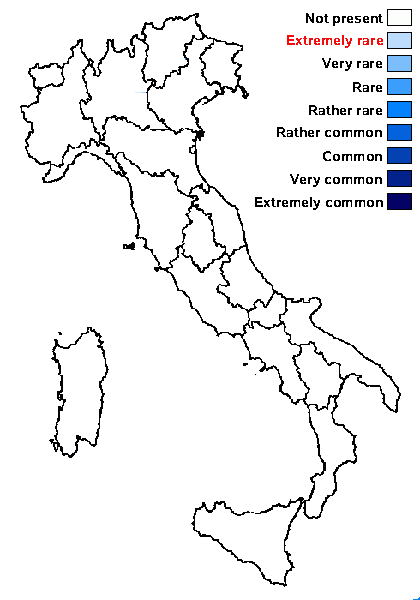Micarea minima Poelt & Döbbeler
Bot. Jahrb., 96, 1-4: 342, 1975
Synonyms:
Distribution:
Description: Thallus crustose, inapparent, reduced to a few algal clumps and hyphae with haustoria in the surroundings of apothecia, developing on the leaflets of Polytrichum, especially on the lamellae. Apothecia on the upper side of the leaflets, micareoid, whitish, translucent when wet, hemispherical, (0.05-)0.07-0.1(-0.15) mm across, without a distinct proper margin. Proper exciple poorly developed; epithecium and hymenium colourless, K-, C-; paraphyses scanty, branched and anastomosing, 1.5-2 μm thick, the apical cells swollen and distinctly clavate; hypothecium colourless, of isodiametrical cells. Asci 8-spored, clavate, the I+ blue tholus with a wide, I+ dark blue tube structure. Ascospores 0-1-septate, hyaline, narrowly ellipsoid to almost bacilliform or rod-shaped, straight or slightly curved, (5.5-)6-7(-8) x 1.5-2 µm, with rounded ends. Photobiont chlorococcoid. Spot tests: thallus K-, C-, KC-, P-. Chemistry: unknown, probably without lichen substances.Note: a very small, easily overlooked lichen developing on leaflets of moribund to dead Polytrichum, apparently widespread in Europe from the lowlands to the montane belt, with a single record from the Eastern Alps (Carinthia, Austria); to be looked for in Italy. The generic placement is not certain.
Growth form: Crustose
Substrata: soil, terricolous mosses, and plant debris
Photobiont: green algae other than Trentepohlia
Reproductive strategy: mainly sexual

Predictive model
Growth form: Crustose
Substrata: soil, terricolous mosses, and plant debris
Photobiont: green algae other than Trentepohlia
Reproductive strategy: mainly sexual

Predictive model
 INDEX FUNGORUM
INDEX FUNGORUM
 GBIF
GBIF

